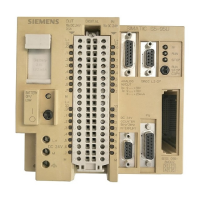Program instructions
7.7 Pulse output
S7-200 SMART
System Manual, V2.3, 07/2017, A5E03822230-AF
287
PTO provides a square wave with a 50% duty cycle output for a specified number of pulses
at a specified frequency. Refer to the figure below. PTO can produce either a single train of
pulses or multiple trains of pulses using a pulse profile. You specify the number of pulses
and the frequency:
Number of pulses: 1 to 2,147,483,647
Frequency:
– 1 to 100,000 Hz (multiple-segment)
– 1 to 65,535 Hz (single-segment)
Use the following formula to convert from cycle time to frequency:
where:
See the following table for pulse count and frequency limitations:
Table 7- 15 Pulse count and frequency in the PTO function
Frequency defaults to 1 Hz
Frequency defaults to 100,000 Hz
Pulse count defaults to 1 pulse
Pulse count > 2,147,483,647
Pulse count defaults to 2,147,483,647 pulses
Note
When using a PTO with very short cycle times (high frequencies), you should take into
account the switching delay specifications for the output points and how the switching delay
can affect th
e duty cycle. See Appendix A for the digital output switching delay for your CPU.
The PTO function allows the "chaining" or "pipelining" of pulse trains. When the active pulse
train is complete, the output of a new pulse train begins immediately. This allows continuity
between subsequent output pulse trains.

